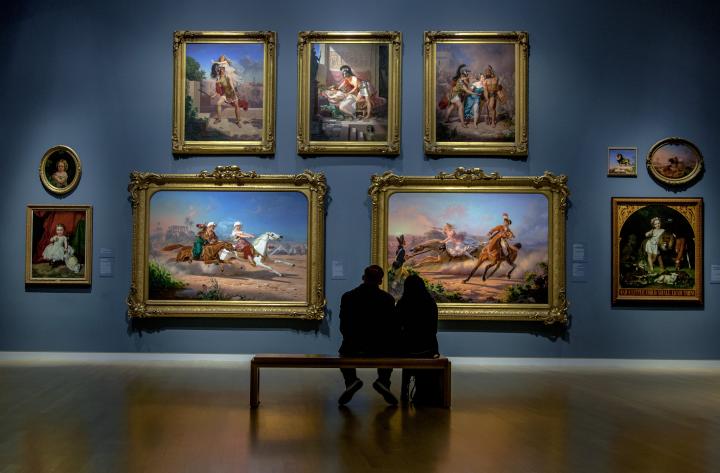
At the Deloitte Private Art & Finance Conference in New York, art investors did something almost unheard of: they dismantled the investment case for their own asset class.
The 17th edition of the conference, which brought together private banks, family offices, collectors and advisors, revolved around a deceptively simple question: is art a viable investment vehicle for family offices and wealth managers? Many concluded it isn’t.
“Investing in art through a fund is expensive unless it’s very large, well managed, and low cost,” said Philip Hoffman, founder of the Fine Art Group, which manages nine funds and advises private banks and family offices on art finance. “I’ve yet to see a fund in the market that does that,” he told Investment Officer.
A panel of art investment specialists echoed that sentiment. Betsy Bickar, head of art advisory at Citi Wealth, said art should be approached as a cultural asset, not a financial one. “We don’t even use the word ‘investment’,” she told the audience.
“The value of art to us is opportunity cost, legacy and culture. Of course people want what they buy to hold its value, but you have to be okay with the idea that it could go to zero.”
Her team focuses on “curatorial due diligence”: understanding the artist, the condition of the work, and its place within an oeuvre, rather than financial forecasting. “Each work has its own life cycle. It’s very difficult to treat them as an asset class for that reason,” she said.
Jeffrey Horvitz, chief executive of Moreland Wealth Services and Agate Fund Management, ran through the structural reasons for that conclusion.
“Imagine a market where it costs you 20 percent to buy and 20 percent to sell,” he said. “If that were the stock market, it couldn’t exist.” With US capital gains tax on collectibles at 28 percent, plus surcharges and state levies, he estimated that long-term net returns rarely exceed 6.5 percent a year.
Allocations come back to Earth
The recalibration of expectations bears out in numbers. Deloitte found that average allocation to art and collectibles among family offices fell to 8.8 percent in 2025, down from 13.4 percent in 2023. None reported clients with more than 30 percent exposure. Most now fall between 3 and 10 percent, roughly the range private banks consider suitable for “passion assets.”
The consultancy estimates that the holdings of ultra-high-net-worth individuals in art and collectibles increased from 2.17 trillion dollars in 2022 to 2.56 trillion dollars in 2024, and could reach 3.47 trillion dollars by 2030 as global wealth expands.
Even so, the latest Art Basel and UBS survey shows that high-net-worth individuals are trimming their exposure to art. Average allocations stood at 22 percent in 2020 and 2021, ticking up to 24 percent in 2022. This year, they fell to just 15 percent.
Panelist Lars Nittve, chair of the investment committee at Arte Collectum and founding director of the Tate Modern, said his fund focuses on artists who have historically been excluded from the mainstream art market. “You have to choose the works museums dream of borrowing for their next retrospective,” he said. “Those are the ones that keep their value, even in a downturn.”
A market hitting its limit
Wealth managers too are scaling back. Only 51 percent of firms surveyed this year said they now offer art-related services, down from 63 percent in 2023. Among private banks the figure fell to 50 percent, and among family offices to 52 percent, according to Deloitte’s Art & Finance Report 2025, which surveyed 37 family offices and 65 private banks worldwide. Nonetheless, about three-quarters of art professionals and wealth managers still believe art should be part of wealth management.
Deloitte attributes the pullback partly to regulatory and operational hurdles. Money managers have grown wary of art-related services due to the art market’s perceived complexity, lack of standardization and compliance challenges. Lackluster returns could also play a role.
The Artnet Fine Art Top 100 index has returned an annualized 3.2 percent over the past 20 years, compared with 10.4 percent for the S&P500. Over the past decade, the gap has widened: a negative 2.9 percent compound annual growth rate for top-tier art, versus 13.3 percent for the US benchmark.
Across the board, appetite for art as an investment is fading. Among art professionals, interest in art-focused financial products has dropped from 26 percent in 2023 to 12 percent this year. Collectors show a similar decline, from 32 to 17 percent. Even wealth managers, historically the most pragmatic supporters of art’s diversification value, have edged lower, from 23 to 16 percent.
Passion projects can be costly
According to Hoffman, The Fine Art Group has recorded a 15 percent gross internal rate of return per year between 2004 and 2020. But he was quick to add that fees and management costs reduce that figure significantly. “Art is a very smart investment if you cut out the frictional costs and know your way around the market,” he said. “Without that, I wouldn’t touch it.”
Still, Hoffman believes there are more efficient ways for institutions to gain exposure to art without the headaches of direct ownership. “We offer art-backed lending,” he said. “It’s structured like a private debt fund, with returns around 10 percent per year net of fees. Pension funds and institutional investors like the steady, lower-risk nature of these loans.”
His firm typically lends up to 50 percent loan-to-value against blue-chip art, roughly the top 2,000 artists that appear in Sotheby’s and Christie’s evening sales. “The artwork would have to lose half its value before we take a loss,” he noted.